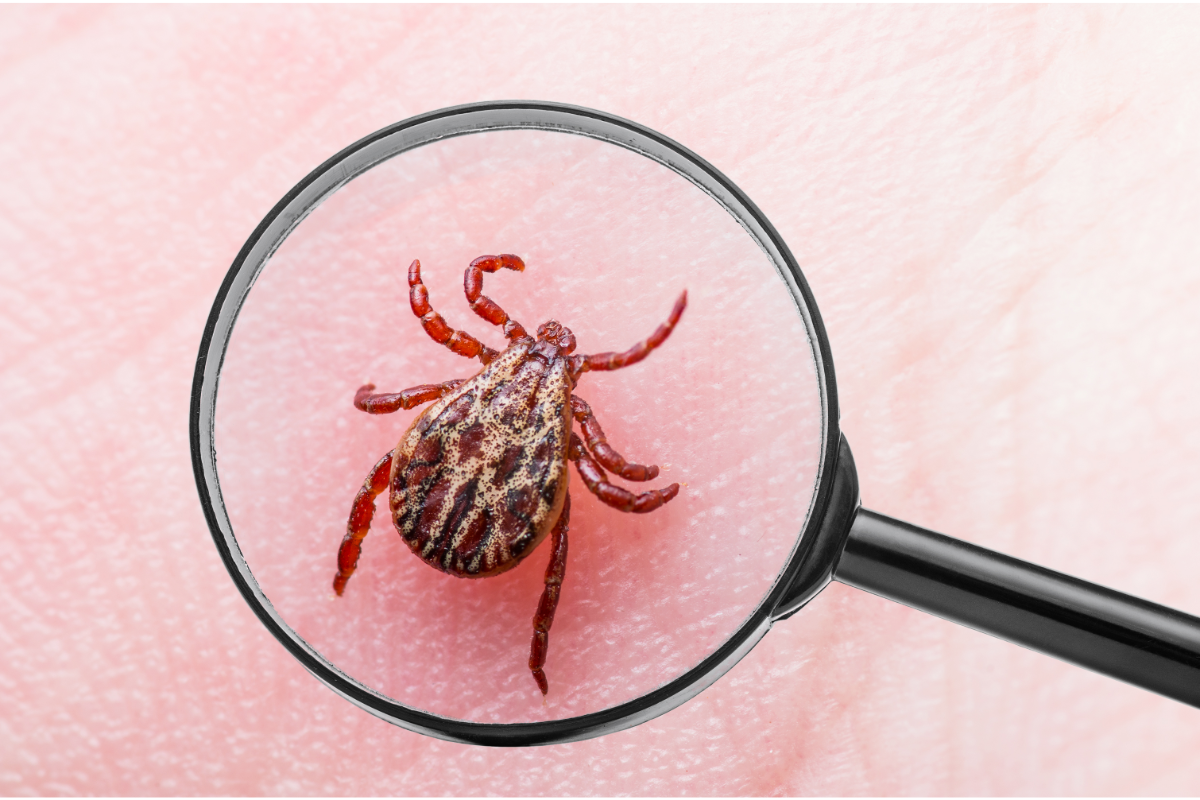Lyme disease, also known as Lyme borreliosis, is a bacterial infection caused by the bacterium Borrelia burgdorferi. It is mainly transmitted to humans by tick bites, particularly from ticks of the genus Ixodes. This disease is a major public health concern, particularly in wooded and humid regions where ticks are abundant. Symptoms of Lyme disease can vary considerably from one person to another, and evolve over time.
What is the infectious agent involved?
Lyme disease is an infection caused by the Borrelia bacterium, transmitted to humans by the bite of an infected tick. In Europe, several species of Borrelia, including mainly B. burgdorferi sensu lato (sl), B. garinii and B. afzelii, are responsible for this disease. In the United States, only B. burgdorferi sensu stricto (ss) is predominant.
Discovered in 1975 following numerous cases of arthritis in children and adults in Lyme, Connecticut, the disease can affect various organs: the skin, joints and nervous system. In North America, B. burgdorferi ss mainly causes Lyme arthritis and rheumatic pain. In Europe, B. garinii mainly causes neurological problems and B. afzelii causes skin problems such as chronic atrophic acrodermatitis.
The rate of tick infection varies from 5% to 35% depending on the region, so a tick bite does not always lead to Lyme disease. On the other hand, no acquired immunity develops after an infection, which means that you can be reinfected.
Recent studies show that some strains of Borrelia are more pathogenic than others. For example, a 2009 analysis of ticks in Germany revealed that 84% of Borrelia belonged to the species B. afzelii, 11% to B. burgdorferi, 3% to B. garinii and 3% to B. spielmanii.
It is crucial to prevent tick bites and to look for them after any walk in nature, as transmission does not occur through contact with an infected animal or between people.
How does infection affect animals?
The natural reservoirs of the bacterium responsible for Lyme disease are mainly small rodents, wild birds and reptiles. Wild mammals such as cervids and suids, although hosts to adult ticks, do not transmit the bacterium to an uninfected tick. Domestic animals such as dogs, cattle and horses can also be affected.
Clinical signs in natural reservoirs are often asymptomatic, without affecting their survival. In domestic animals, symptoms may appear a few weeks or months after the infecting bite. In dogs, for example, joint and muscle damage can be observed, accompanied by fever, anorexia and apathy. In cattle, symptoms such as fatigue, inappetence, reduced milk production, fever, recurrent arthritis, lameness and difficulty getting up are common.
The transmission cycle of the bacterium begins with tick larvae and nymphs that become infected by biting small rodents or birds. These infected ticks then transmit the bacteria to other hosts in the adult stage. White-tailed deer, although often carriers of adult ticks, do not transmit the bacterium to ticks.
Domestic animals can be severely affected. In dogs, only 5-10% of infected individuals show clinical signs, which appear 2-5 months after the bite. If left untreated, the disease can lead to cardiac, nervous or renal complications that are often fatal. In horses, donkeys and mules, behavioural changes and nervous signs may occur, as well as eye problems.
By exposing themselves to ticks, humans become accidental terminal hosts. It is crucial to prevent tick bites and to look for ticks after activities in nature.
Spotlight on ticks
The main vectors of Lyme disease are ticks of the genus Ixodes. These ticks transmit the disease to three successive hosts over a period of 2 to 7 years, depending on the species and the climate. In North America, the main vector is Ixodes scapularis (or I. dammini), particularly in the north-east and mid-west. Nymphs and adult females can bite humans. In the West, Ixodes pacificus is responsible for 5% of cases, although its pathogenic efficacy is lower.
In Europe, Ixodes ricinus is the main vector. It bites humans at all stages of development. In Eurasia, Ixodes persulcatus predominates, especially in Asia and the former USSR. Other haematophagous arthropods, such as horseflies and mosquitoes, could be potential Lyme vectors. However, this role is still under discussion.
The proportion of infected ticks varies according to several factors: stage of development, species, season and region. For example, less than 2% of I. pacificus in California are infected, compared with 30% in France and 60% in Austria. In France, an INRAE study in 2021 revealed that 15% of ticks biting humans carry Borrelia burgdorferi sensu lato.
The bacterium develops in two stages: first in the midgut of the larva. It then becomes motile as a result of the blood meal and penetrates the adult tick’s salivary glands. It is then transmitted to the next host when the tick bites.
In exceptional cases, the bacterium can be transmitted vertically from the tick to its offspring. In 2017,INRA launched a citizen science project to find out more about Lyme disease vectors. This project enables everyone to report tick bites via a smartphone app.
How is it transmitted?
Lyme disease is transmitted mainly by the bite of a tick of the genus Ixodes, in Western Europe mainly Ixodes ricinus. These ticks become infected by feeding on the blood of animals contaminated with bacteria. In France, the tick infection rate varies between 2% and 32% depending on the region. Ticks are found throughout mainland France, except on the Mediterranean coast and above altitudes of 1,500 to 2,000 metres. They live in forests, borders, meadows, urban parks and private gardens, requiring a certain amount of humidity to survive.
Ticks transmit Lyme borreliosis mainly in the nymph stage and sometimes in the adult stage. Infected mammals or tick carriers do not transmit the disease directly to humans. Contamination occurs when humans encounter tick vectors in damp woodland environments. Ticks can be found in plant cover less than a metre high. They detect hosts using sensors sensitive to CO2, heat and biochemical substances.
Once on the host, the tick seeks out warm, moist areas such as the folds of the body. It settles in for its blood meal, which lasts from 3 to 5 days. Bacteria are transmitted during this meal. The bacteria pass from the digestive tract to the salivary glands and then to the host’s epidermis. The risk of developing Lyme disease after a tick bite is between 1 and 5%.
Lyme disease is not transmitted between humans. Mother-to-child transmission in utero is possible, but with no effect on the foetus if the mother is treated with antibiotics. Other modes of transmission, such as direct contact or blood transfusion, have not been demonstrated.
How does the disease manifest itself in humans?
Lyme disease is often asymptomatic. Approximately 3 to 30 days after the bite, a reddening of the skin appears at the site of the bite. This redness gradually spreads and may lighten in the centre (erythema migrans). If left untreated, in 10% of cases other organs may be affected 2 weeks to 6 months after the bite. The nervous system may be affected, causing tingling, facial paralysis or meningitis. Joints may also be affected, leading to arthritis of the knee or elbow. More rarely, the heart,eye or skin (skin nodule often around the ear) may be affected. If left untreated for more than 6 months, late symptoms may occur, affecting the joints and nervous system or causing localised skin atrophy. Lyme disease develops in three distinct phases.
Primary phase
The primary phase of Lyme disease appears approximately 2 to 32 days after the bite of an infected tick. The main manifestation is a skin lesion called erythema migrans. This lesion, also known as erythema migrans, appears as a red halo around the bite, spreading out centrifugally and becoming lighter in the centre. The diameter of the erythema varies from 3 cm to several dozen centimetres, with an average of 15 cm. This redness is not painful and disappears spontaneously in a few weeks. It may not appear in 30 to 50% of cases.
Other symptoms may accompany erythema migrans, such as moderate fever, fatigue (asthenia), muscle pain (myalgia) and headaches (present in around 25% of patients).
The skin lesion spreads progressively, often lightening between the centre and the periphery, resembling a bull’s eye. A dark erythema may develop in the centre, which may be warm and indurated to the touch. Without treatment, erythema migrans usually disappears within 3 to 4 weeks.
Most patients present with a single lesion, but some may develop multiple erythema migrans lesions, a sign of early haematogenous dissemination. Apparent relapses after treatment are often due to reinfection rather than relapse, as the genotype of the new lesion differs from that of the initial infection.
In Europe, erythema migrans is generally painless and non-itchy, with less intense inflammation than in North America. The erythema often grows more slowly. In North America, the lesions may be multiple and more inflammatory, with the risk of central necrosis or vesicles. Erythema migrans disappears spontaneously in 4 to 6 weeks, but early treatment leads to faster healing and prevents complications.
Secondary phase
In the secondary phase of Lyme disease, the bacteria can spread through the bloodstream, leading to complications if left untreated. Symptoms may appear on the skin, joints, nerves or heart. These manifestations occur a few days to a few weeks after the primary phase, but can sometimes be present at the same time as the erythema migrans.
Multiple erythema migrans may appear all over the body and progress in relapses, which is common in the United States but rare in Europe. Benign cutaneous lymphocytoma may also occur at this stage, appearing as a small, prominent, reddish-purple lesion 1 to 2 cm in diameter, usually on the earlobe, nipple or scrotum.
Joint pain (arthralgia) may last several days and affect one or more joints. Inflammation of the joints (arthritis) may appear later, mainly in the large joints (knees, shoulders), and develop in flare-ups. They may heal spontaneously.
Nervous signs are varied. They include headaches and pain along the nerves(neuralgia). Damage to nerve roots(hyperalgesic radiculitis) causes severe pain. Facial paralysis and lymphocytic meningitis may also occur.
Some people may develop heart problems. These are mainly rhythm or conduction disorders. More rarely, pericarditis or myocarditis may occur. These symptoms are intermittent and often resolve spontaneously.
Rarely, ocular damage may occur, such as conjunctivitis, keratitis or uveitis, causing redness, pain, tearing, photophobia and possible loss of vision. These symptoms generally appear a few weeks to a few months after the initial infection, often in the absence of appropriate antibiotic treatment.
This stage corresponds to bacterial dissemination, followed by a focus on specific tissues, dominated in Europe by neurological disorders and in America by rheumatological disorders.
Tertiary phase
The tertiary or late phase of Lyme disease corresponds to a chronic progression of symptoms. This phase, which is less frequent, appears in the absence of treatment after a few months to several years. The main manifestations of this phase are cutaneous, articular and nervous.
Chronic atrophic acrodermatitis (Pick-Herxheimer disease) appears several years after infection. It is characterised by a purplish, swollen lesion, mainly on the backs of the hands, elbows, ankles and knees. This lesion progresses to skin atrophy, where the skin becomes thin, wrinkled and translucent, with veins showing through.
In the late phase,arthritis becomes chronic, mainly affecting the large joints. It causes long-lasting pain with abnormalities visible on X-ray. This arthritis is often resistant to antibiotic therapy and may persist for several years.
Late-onset neuroborreliosis includes damage to the brain (chronic encephalopathy). It causes various psychiatric or neurological disorders. Symptoms include cognitive problems, difficulty concentrating, fatigue, pain, muscle weakness and motor disorders. Polyneuropathy can manifest as pain and numbness in the hands and feet. This condition is often associated with atrophic acrodermatitis.
The boundary between the secondary and tertiary phases is difficult to establish. A secondary phase may be prolonged and become tertiary, or tertiary manifestations may appear years after the initial infection. Autoimmune phenomena could explain these symptoms, although the direct responsibility of the bacteria remains debated.
Controversial manifestations include dermatological disorders (morphea, scleroderma, dermatomyositis) and chronic symptoms (headaches, fatigue, joint pain) following antibiotic treatment. Doctors refer to these symptoms as post-borreliosis Lyme syndrome (PLDS). The term “chronic Lyme disease” covers a range of chronic conditions attributed to Lyme disease, although there is some controversy as to whether they are directly linked to Borrelia.
How is the diagnosis made?
The diagnosis of Lyme disease is based on a clinical examination and detailed questioning. Doctors look for the presence of a red halo (erythema migrans) and the memory of a tick bite. Diagnosis is difficult in the absence of erythema migrans and when the tick bite has gone unnoticed. The symptoms of this disease are varied and can be confused with many other illnesses.
Blood counts (CBC) and sedimentation rates (ESR) are often normal. To clarify the diagnosis, serological tests can detect antibodies in the blood, indicating an immune response to the bacterial infection. However, these tests are not standardised and can be difficult to interpret. The results are often negative in the first phase of the disease and positive in the secondary and tertiary phases. Positive serology may indicate an old infection that has not progressed. Occasionally, serology may be negative despite actual infection.
PCR (Polymerase Chain Reaction) can detect the DNA of the bacteria and is used in certain specific situations. If the nervous system is affected, a lumbar puncture can be used to look for antibodies in the cerebrospinal fluid to help with the diagnosis.
Skin manifestations of the disease may be confused with other problems. These include a fungal infection or an inflammatory reaction to an insect bite. Lyme disease can also be confused with conditions such as lupus, viral infections, multiple sclerosis and fibromyalgia.Clinical examination remains essential, supplemented by serological tests if symptoms are suggestive.
In 2019, confirmatory diagnosis will be based on two-stage serology. This applies to each stage of the infection.Erythema migrans is sufficient to confirm infection.
Is there a treatment for Lyme disease?
The curative treatment for Lyme disease uses antibiotics, administered rapidly for optimum effectiveness. In the primary phase, doctors prescribe amoxicillin or cyclins for two to three weeks. In the late phase, they use intravenous 3rd generation cephalosporins. In cases of allergy, healthcare professionals can use macrolides and tetracyclines, despite certain side-effects. In the case of antibiotic-resistant chronic arthritis, synoviorthesis or synovectomy may be considered. Management of the disease follows standardised recommendations issued at the 2006 Consensus Conference and updated in 2020 by the Infectious Diseases Society of America (IDSA), the American Academy of Neurology (AAN ) and the American College of Rheumatology (ACR).
Antibiotic treatments
The aim of antibiotic treatment of Lyme disease is to cure the clinical manifestations and prevent progression to secondary and tertiary forms, by eradicating the Borrelia. The aim is not to achieve negative serology.
In the primary phase (erythema migrans),amoxicillin or doxycycline is prescribed for 14 to 21 days, ideally within 72 hours of infection for greater efficacy. Most forms of the disease respond well to antibiotic therapy, especially in the early phase.
In the late phase, antibiotics reduce the symptoms of arthritis in most patients, although some genetically predisposed individuals may suffer from persistent arthritis despite eradication of the infection due to ongoing inflammation. For neuroborreliosis, cephalosporins (mainly ceftriaxone) are administered intravenously for 21 to 28 days.
For symptomatic relief, non-steroidal anti-inflammatory drugs (NSAIDs) may be used. In cases of complete atrioventricular block, a temporary pacemaker may be required. Large joint effusions require punctures and, in some cases, arthroscopic synovectomy.
In May 2019, the French learned societies recommended doxycycline as first-line treatment for erythema migrans (14 days) and neuroborreliosis (14 days for early treatment, 21 days for late treatment), with amoxicillin as an alternative. For joint manifestations, doxycycline, ceftriaxone or amoxicillin are prescribed for 28 days.
Around 15% of patients may experience a Jarisch-Herxheimer reaction after initiation of antibiotic therapy. This transient exacerbation of symptoms disappears within a few hours to two days.
Recent research in 2021 suggests a potential microbial treatment using hygromicin A. This treatment could eradicate Lyme disease in the natural environment.
Approximately 10% of treated patients continue to experience persistent subjective complaints beyond 6 months after treatment. These include fatigue, muscle pain and cognitive problems, known as post-Lyme disease syndrome (PLDS).
Phyto-aromatherapy
Various laboratories offer phytotherapeutic preparations to treat Lyme disease.
Several plants, including Ghana quinine (Cryptolepis sanguinolenta) and Japanese knotweed (Polygonum cuspidatum), have been studied. In vitro tests on Borrelia cultures have shown encouraging results. These results require further confirmation.
In France, Tic Tox is a mixture of essential oils and propolis. Bernard Christophe (1949-2016), a pharmacist specialising in phyto-aromatherapy, developed this product. In 2012, the French National Agency for the Safety of Medicines and Health Products (AFSSAPS) suspended this product because of its composition. It included sage (potentially toxic depending on the dose ingested) and a terpene, thujone. It also did not havemarketing authorisation.
The preliminary results of studies on medicinal plants offer interesting prospects, but further research is needed to confirm their efficacy and safety. In the meantime, caution should be exercised when using these unregulated products.
Alternative treatments
When prolonged antibiotic therapy fails to treat chronic post-borreliosis conditions, new management strategies need to be implemented. Nearly 40% of patients suffering from post-borreliosis Lyme syndrome show improvement with a placebo. These patients join the millions of people suffering from chronic fatigue and pain of undetermined origin.
Depressive disorders should be treated in accordance with the usual standards, and persistent pain should be treated using a multidisciplinary approach, similar to that used to treat fibromyalgia. This approach includes combinations of drugs (analgesics, antidepressants), behavioural therapies, physiotherapy and acupuncture.
Neuromodulation techniques using spinal stimulation, developed to treat complex chronic pain syndromes, can reduce the pain of patients suffering from chronic Lyme arthritis resistant to conventional treatments. At the same time, vaccines are being developed.
The Internet offers many alternative treatments. However, their effectiveness has not been proven, and some present risks of adverse effects. These treatments include :
- Prolonged, intermittent or repeated antibiotic therapy with no proven efficacy.
- Hyperbaric medicine.
- Pseudo-scientific radiation or energy therapies.
- Nutritional therapies.
- Heavy metal chelation.
- Pyrotherapy.
- Various medications: immunoglobulins, hormones, bee venom.
These approaches have not been scientifically validated. The medical profession does not recommend them because of their lack of evidence of effectiveness and the potential risks for patients.
How can contamination be prevented?
Preventing Lyme disease involves taking precautions in high-risk areas. Wear clothing that covers your legs, arms and neck, and use repellents when walking or working in the woods. Inspect yourself carefully after each outing to look for and remove ticks quickly. Remove the tick as soon as possible using tweezers, taking the tick as close to the skin as possible without forgetting the head, and then disinfect the area.
Experts advise against using ether to extract the tick. For pets (cats, dogs, horses), recommendations recommend the use of tick repellent powders to treat the animals and their environment.
In the event of a tick bite, prophylactic antibiotic treatment is generally not necessary, except in the case of pregnant women, where there is still a risk of transmitting the infection to the foetus.
A vaccine developed in the United States, now withdrawn from the market, targeted only Borrelia burgdorferi, a specific species that does not predominate in Europe. Primary prevention is difficult because of the diversity of animal reservoirs. In the United States, reducing the white-tailed deer population is being debated as a means of reducing human disease.
In gardens, maintaining frequented areas by mowing tall grass and removing dead leaves can reduce tick abundance. A buffer zone between wooded areas and play areas can also be effective.
For pets, using tick collars and inspecting them regularly after outings in the forest is crucial. In the event of a tick bite, remove the tick quickly, disinfect the wound and watch out for symptoms such as erythema migrans.
There is currently no human vaccine available against Lyme disease. Veterinary vaccines do exist for dogs. They are based on the whole killed bacterium or on protein sub-units.
Some epidemiological data…
Lyme disease is an infection caused by the bacterium Borrelia burgdorferi and is transmitted to humans by infected ticks. It is found on every continent, but predominates in the temperate zone of the northern hemisphere. The areas most affected are between 35° North and 60° North latitude, mainly in Europe and North America.
The incidence of Lyme disease is on the rise, with variations from region to region and country to country. In the United States, nearly 30,000 cases are reported each year. Studies estimate that the actual number of diagnosed cases could be as high as 300,000. In Europe, particularly in Slovenia and Austria, the incidence is also on the rise, with more than 100 cases per 100,000 inhabitants.
In France, in 2020, the annual incidence of Lyme borreliosis was estimated at 91 cases per 100,000 inhabitants. However, this incidence varies considerably from region to region. Prevalence is highest in the north-east and centre of the country.
Global warming is increasing the prevalence of the disease. It influences the distribution and density of infected ticks. Human activities such as draining wetlands also contribute to the spread of the disease. Forest fragmentation disrupts natural ecosystems and encourages the spread of the disease.
Early detection of Lyme disease is essential for effective treatment. Standard treatment consists of antibiotics, but in some cases persistent symptoms may require prolonged therapy.
Controversy surrounding the diagnosis and treatment of Lyme disease persists, with differing opinions among patient organisations and learned societies. Further research is needed to better understand the disease’s transmission mechanisms and develop more effective prevention strategies.
Lyme: a bacteriological weapon?
Borrelia, including those associated with Lyme disease, are not listed as potential bioterrorism agents. In 2004, Michael Carroll, a Long Island lawyer, published a book entitled Lab 257. The book puts forward conspiracy theories. Carroll alleges that Erich Traub, a Nazi scientist who fled to America, worked at Fort Detrick. There he conducted research into foot-and-mouth disease and the manipulation of ticks on Plum Island, near the town of Lyme. However, Carroll admits that he has no evidence to back up his claims.
In 2016, in France, the controversial infectiologist Christian Perronne relayed these allegations. He suggested that the US military and scientists under its influence had covered up the explosion of Lyme disease. This constitutes a conspiracy theory.
In 2019, Kris Newby published a book entitled Bitten, the secret history of Lyme Disease and biological weapons. She claims to have interviewed Willy Burgdorfer, discoverer of the Lyme disease agent in 1982. Burgdorfer allegedly claimed to have worked on biological weapons for the US army during the Cold War. He is said to have bred fleas, ticks and other arthropods to infect them with pathogens. He is said to have suggested that such an experiment got out of hand, triggering the Lyme epidemic in the United States.
However, no one has put forward any tangible evidence to support this claim. In response to these publications, New Jersey Republican Representative Chris Smith proposed an amendment. This amendment was aimed at investigating these accusations. The Senate rejected this request. The Plum Island Animal Disease Center (PIADC), located near Lyme, denies having conducted any research into Lyme disease. It also denies any classified research.
The fight against the disease
At the instigation of patient associations and doctors, in September 2016 the Ministry of Health announced the implementation of a National Plan to combat Lyme disease and tick-borne illnesses. This plan has several components:
- Installation of information and warning signs at forest entrances for walkers and hikers.
- Development of a mobile application for reporting the presence of ticks, similar to the existing one for mosquitoes.
- Stepping up information campaigns aimed at the general public and training for healthcare professionals.
- Providing doctors with a standardised report describing the tests required for a full diagnosis in people presenting symptoms suggestive of the disease.
- Establishment of a National Diagnosis and Care Protocol (PNDS ) to guarantee standardised, reimbursed treatment throughout France.
- Opening of specialised care centres in 2017, also dedicated to training professionals.
- Creation of a cohort of patients monitored in these centres to enhance scientific knowledge of the disease.
- Promotion of diagnostic research by the Institut Pasteur.
- In-depth research as part of a project supported by the SPILF. The aim is to gain a better understanding of all tick-borne diseases.
The plan also envisages assessing the possibility of including Lyme disease in the list of long-term conditions (ALD), a request made by patients’ associations.
Against this backdrop, Santé publique France ‘s objectives are to monitor Lyme borreliosis through the Sentinelles Network and the National Borrelia Reference Centre . Their mission is to monitor changes in the public’s knowledge and perception of this disease, and to promote its prevention. To achieve this, a three-tier organisation of care has been put in place, in line with the recommendations of the French National Authority for Health.





